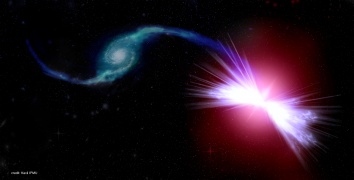Supermassive Black Holes Cause Galactic Warming
25 May 2016
For most of their lives, galaxies are lush environments for turning gas into stars. Until they aren’t.
Over the last few billion years, a mysterious kind of “galactic warming” has turned huge numbers of galaxies into deserts devoid of fresh young stars. The puzzle for astronomers has been identifying the unknown process that keeps the gas in these dormant galaxies too hot and energetic to form stars.
Today, astronomers from the Sloan Digital Sky Survey (SDSS), including Dr. Niv Drory of The University of Texas at Austin, are announcing the discovery of a new class of galaxies called “red geysers” that harbor supermassive black holes with winds that have the power to keep dormant galaxies quiet.
“We knew that there had to be a way to prevent star formation in these galaxies, and now we have a good idea of what it is,” says Edmond Cheung, the lead author of the study published today in the journal Nature. Cheung, an astronomer at the University of Tokyo’s Kavli Institute for the Physics and Mathematics of the Universe, was working with an international team of astronomers studying hundreds of galaxies when they caught a supermassive black hole blasting away at the cold gas in its host galaxy.
“Galaxies start out as star-making machines with a simple recipe: gas plus gravity equals stars,” says Kevin Bundy, co-author on the study and Principal Investigator of the new SDSS campaign that led to the discovery. “Here we have a galaxy that has everything it needs to form new stars, but is dormant. Why is that?”
Astronomers had long suspected that the reason had something to do with the supermassive black hole found at the centers of many galaxies, but solid evidence was lacking. One reason was that it used to be difficult to map the internal structure and motions of gas and stars throughout a galaxy. “If we looked just at the center of the galaxy like we used to, we could have learned about the central black hole, but we would have missed the story of how it affects the rest of the galaxy,” Cheung says. “Another reason is that the wind from supermassive black holes comes and goes quickly, so catching the wind red-handed is hard.”
The secret to capturing the whole story is the SDSS’s new component survey, Mapping Nearby Galaxies at Apache Point Observatory (MaNGA).
Texas’ Drory built the MaNGA instrument that makes this survey possible. Drory is currently the Instrument Scientist for the project.
“The MaNGA Project's strength and uniqueness lies in the fact that we decided to not pre-select the galaxies we observe other than by the fact that they would be bright enough for the telescope and instrument we're using,” Drory said. “We were hoping that by observing many more galaxies than ever before, we'd find both the normal guys and the really unusual ones — the ones that teach us something new about galaxies in general. The object we've discovered here is a perfect example of how well that is working. These are very exciting times to be working on galaxy formation with new data like MaNGA that we've only been able to dream about until now."
Survey Scientist Renbin Yan of the University of Kentucky explained that ““Since MaNGA studies so many galaxies, our snapshots can reveal even the quickest changes happening in galaxies. And that’s how we found Akira.”
Cheung nicknamed this premier example of a red geyser galaxy “Akira” after the famous Japanese manga comic character, an homage to both the MaNGA survey and his home institution in Japan. Akira has a companion galaxy that Cheung called “Tetsuo” for another character in the same manga. Akira is pulling gas away from Tetsuo, which fuels Akira’s supermassive black hole winds. The winds driven by Tetsuo’s gas are the reason that Akira is currently a red geyser galaxy. Bundy came up with the name “red geyser” because these wind outbursts reminded him of the sporadic eruptions of a geyser and because the failure to form new stars leaves the galaxy with only red stars.
As with global warming on Earth, galactic warming has long-term consequences for red geyser galaxies: Their gas can no longer form new stars. “You can think of these winds as super-heating the atmospheres of galaxies,” Cheung says. “As soon as any gas starts to cool, it gets blasted by this wind, like water droplets turning to steam.” The team theorizes that this phenomenon is quite common in dormant galaxies. Therefore, our own Milky Way galaxy may not be safe from this galactic warming. Distant future generations may see our supermassive black hole turning our galaxy into a red geyser.
END
Contact:
Dr. Niv Drory, Research Scientist
McDonald Observatory
The University of Texas at Austin
512-471-6197






